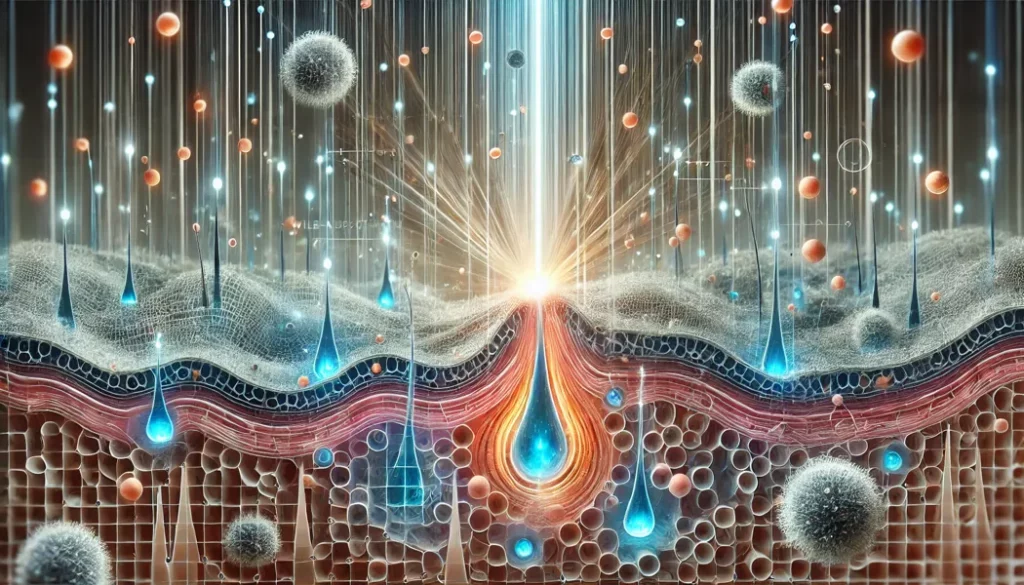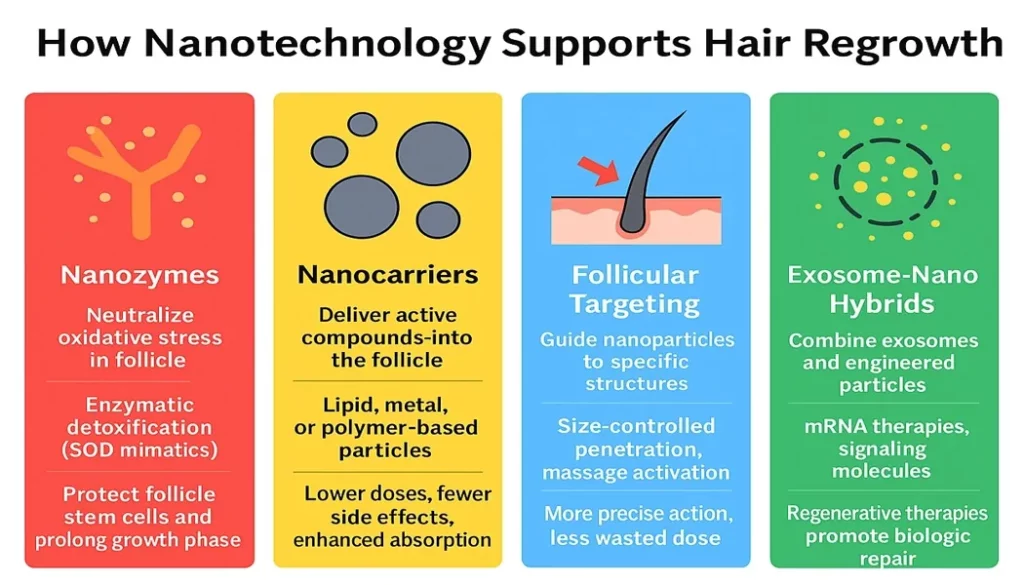Hair loss affects more than just appearance—it chips away at confidence, identity, and emotional wellbeing. And for those who’ve tried every shampoo, serum, and supplement on the shelf, the question is no longer “what else is there?”—but “what actually works?”
In the past, most treatments focused on symptom management: blocking DHT, stimulating blood flow, or supplying nutrients. But they often lacked precision, consistency, and depth. Now, thanks to nanotechnology, we may finally be witnessing a shift from generic surface care to scientifically targeted follicle support.

This isn’t about miracle cures.
It’s about particles a thousand times smaller than a hair—designed to reach the very root of the problem.
And sometimes, that root problem starts with something deceptively simple: a clogged or inflamed follicle that blocks penetration entirely. If you haven’t addressed this first barrier, even the most advanced formulas might fall short.
In this article, we explore how nanotechnology is unlocking new pathways in the fight against hair loss—and how this silent revolution might become the smartest addition to your long-term hair strategy.
🧬 What Exactly Is Nanotechnology—and Why Does It Matter for Your Hair?
Nanotechnology refers to the manipulation of matter at the scale of 1 to 100 nanometers—particles so small they can pass through biological barriers like the skin, the scalp, and even the follicular opening. But what does that mean for hair growth?
In conventional topical treatments, many active ingredients never reach the base of the follicle where real regeneration begins. That’s where nanotechnology makes a difference. By shrinking active compounds into nano-sized carriers, scientists can improve their penetration, stability, and targeting. These particles don’t just sit on the scalp—they go deeper, bypassing the stratum corneum and reaching the dermal papilla, the part of the follicle responsible for hair production. 🎯

Studies have shown that nanocarriers can enhance the bioavailability of hair-supporting compounds and even influence key signaling pathways involved in the hair growth cycle. 📈 This includes promoting the anagen (growth) phase and reducing premature entry into the telogen (resting) phase—an effect that’s often blocked when follicles are clogged or inflamed. You can learn more in our article on clogged hair follicles, where we explore how buildup and inflammation silently sabotage growth.
But perhaps most importantly, nanotechnology allows for controlled, sustained release. That means the active ingredients remain in contact with the follicle longer—potentially leading to more consistent, long-term results.
This shift from surface-level care to precise, follicle-directed support represents a major turning point in hair science. And while not all nanoformulations are created equal, the evidence is growing: when used correctly, this technology may offer something many treatments fail to deliver—reliability. 🔬
🔬 Nanozymes and Antioxidant Defense in the Follicle
Your hair follicles are constantly exposed to invisible threats—pollution, UV rays, hormonal shifts, poor circulation—and at the molecular level, all of them have something in common: oxidative stress. This is a state where unstable oxygen molecules (ROS, or reactive oxygen species) start to damage cells faster than your body can repair them.
Oxidative stress is one of the silent killers of hair health. It damages follicular stem cells, shrinks the dermal papilla, and accelerates entry into the telogen phase. 🧨 Over time, it leads to thinner, weaker strands—or no strands at all.

Enter nanozymes. These are synthetic enzyme-like nanoparticles designed to mimic the body’s natural antioxidant defenses. Unlike standard antioxidants that degrade quickly or act broadly, nanozymes are stable, targeted, and long-lasting. They neutralize ROS right at the follicular level—before damage takes hold.
Recent evidence shows that hyperbranched polymer dots (HPDs)—a drug-free nanozyme strategy—significantly enhanced hair follicle regeneration via Wnt/β-catenin activation in murine models, outperforming conventional treatments and prolonging the anagen (growth) phase (ScienceDirect, 2025).
Studies published in Biomedicine & Pharmacotherapy further confirm scalp rejuvenation and follicle recovery following topical application of nanozyme formulations in mice. One 2025 study reported significant improvements in follicle density and anagen duration using hyperbranched polymer dots as drug-free nanozymes (source: PubMed, 2025).
By protecting stem cells within the follicle, nanozymes help maintain its regenerative potential even under stress.
⚛️ Metal-Based Nanoparticles: Fueling Microcirculation and Follicle Revival
Blood flow is the engine behind every healthy follicle. Without proper microcirculation, your hair roots are starved of oxygen, nutrients, and hormonal signals that regulate growth. Even the most advanced active compounds won’t help if the delivery highway is blocked. 🚧
This is where metal-based nanoparticles show remarkable promise. Recent research highlights how gold, silver, zinc, and iron oxide nanoparticles can stimulate vasodilation, improve endothelial function, and enhance nutrient transport through capillaries in the scalp.
Recent comprehensive reviews―including a 2025 article in Focused Review on Metal Nanoparticles in Hair Regeneration and Alopecia (Pokale et al.)―confirm that metal nanoparticles (gold, silver, copper, iron) can upregulate VEGF expression, enhance microvascular blood flow to follicles, and support antioxidant and anti‑inflammatory defenses, contributing to healthier, more vascularized follicles. (Source)

But the benefits don’t stop at blood flow. These particles also exhibit anti-inflammatory and antioxidant effects, helping calm irritated scalps while supporting a more favorable environment for anagen re-entry.
💡 And here’s where topical care matters: using a DHT-safe, sulfate-free shampoo and a nutrient-rich conditioner helps maintain a clean, receptive scalp barrier — so the follicles can actually benefit from advanced technologies.
🧴 Supporting Nano Action with Smart Topicals and Scalp Tools
Nanotechnology may be the future of hair care, but it can’t perform miracles without support. For these microscopic agents to deliver on their promise, they need a scalp environment that’s clean, balanced, and primed for absorption.
That’s where smart topical care — especially the kind that respects the scalp’s biology — plays a critical role. Using a sulfate-free, DHT-safe shampoo helps protect the scalp’s natural barrier while avoiding irritation that can disrupt follicle function. A high-quality conditioner with botanical extracts and proven ingredients like ginseng, ginger, and safflower extract can further nourish the scalp and reinforce the effect of advanced technologies.

But here’s where things get interesting:
The moment when your conditioner is on your scalp is the perfect time to stimulate blood flow. Massaging the product in with a gentle scalp tool can enhance microcirculation and improve delivery of both natural and nanotech compounds. 🌀
Think of it as a double action:
– The conditioner delivers the nutrients.
– The massage boosts the transportation system.
This synergy between mechanical stimulation and biochemical support is often overlooked — but it’s one of the easiest ways to make your routine more effective, even if you’re not yet using nano-enhanced products or advanced follicle boosters.
Sometimes, it’s not about adding more steps.
It’s about doing what you already do — better.
📊 Infographic – Nanotechnology and Hair Regrowth: A Layer-by-Layer Look
One of the most promising aspects of nanotechnology is where it works — not just what it does. While traditional products often stay on the surface, nanoparticles are engineered to pass through the skin barrier and reach the follicle itself.
This infographic illustrates how nanotechnology works at each of the three key skin layers involved in hair regrowth:

Surface (Scalp Barrier)
– Maintained with sulfate-free shampoos to prevent irritation
– Prepares the skin for deeper action
Epidermis and Follicular Canal
– Nanocarriers penetrate through the stratum corneum
– Allows for improved delivery of active ingredients
Follicle Base (Dermal Papilla)
– Nanozymes neutralize oxidative stress
– Metal-based nanoparticles stimulate blood flow and growth signals like VEGF
– Supports a longer, healthier anagen phase
Together, these layers form a complete system — and when supported with the right topicals and smart tools, the effect can be significantly amplified.
🔎 Are These Technologies Available Now—or Still in the Lab?
With all the breakthroughs nanotechnology promises, one question naturally arises:
Is this something you can actually use today—or is it just futuristic theory?
Some innovations are already here—others are still in testing.
Certain nano-based formulations are available now, found in premium scalp serums, dermatological solutions, and early-stage topical treatments. These may include encapsulated vitamins, antioxidant particles, or metallic nanoparticles designed to support scalp health.
But the most advanced approaches—like targeted follicular delivery systems or nanozyme-loaded carriers—are still undergoing clinical trials.

What matters most is separating marketing hype from real science.
If a product claims “nanotechnology” without transparency—no info about particle size, delivery mechanisms, or published studies—it’s likely just a label.
On the other hand, ingredients backed by peer-reviewed research, combined with a consistent smart care routine, can help you tap into the early benefits of this emerging field.
🧠 And don’t underestimate the power of synergy:
Even the best topical won’t work if your system is overwhelmed. Supporting your nervous system with adaptogens like Rhodiola Rosea or saffron extract can make your follicles more responsive—amplifying the effects of advanced formulations.
True regeneration begins at the intersection of what you apply, how your body receives it, and how consistently you show up.
🌱 The Future Is Closer Than You Think
The most exciting thing about this shift in hair science is not the technology itself—it’s the mindset it demands.
Because real hair regrowth doesn’t begin with a miracle ingredient.
It begins with how you think about your scalp, your health, and your long-term consistency.
Nanotechnology is not a magic bullet. But it is a smarter tool—one that targets problems more precisely, works deeper, and lasts longer than what most people are used to.
It’s already reshaping how scientists view drug delivery, follicular biology, and regenerative dermatology. And while some of its applications are still in development, many are closer to practical use than you might think. 🔬
But here’s the truth:
No product, no particle, no protocol will work if your body is constantly overloaded by stress, inflammation, or neglect.
That’s why the most powerful strategy you can embrace isn’t just what you use—it’s what you support.
→ Support your circulation.
→ Support your hormonal balance.
→ Support your nervous system.
The follicle will follow.
Stronger hair starts with daily choices. Learn 8 proven habits backed by research that fuel growth from within. Download your free PDF guide now!
🧭 Want to stay ahead of the curve? The most groundbreaking nanotech innovations for hair regrowth are just around the corner — and we’ll be covering them next. Don’t miss what’s coming.
📎 Want to know who’s behind HairGrowGenius and why we do this? Read more about us here

❓ Frequently Asked Questions
🔍 What makes nanoparticles different from traditional hair care ingredients?
Nanoparticles operate on a much smaller scale—measured in billionths of a meter—allowing them to penetrate deeper into the scalp than conventional ingredients. This means they can reach the follicular level, where they may deliver antioxidants, growth stimulants, or anti-inflammatory agents directly to target cells.
🧪 Are nano-enhanced hair products safe for daily use?
Most commercially available nano-formulations use ingredients that have passed dermatological safety testing. However, due to their size, nanoparticles should be used as directed and not overapplied. Look for transparent labels and products that cite clinical research to ensure both safety and efficacy.
🔗 Can I combine nanotech treatments with other scalp therapies?
Yes. Nanotechnology often works best as part of an integrative strategy. Combining nano-formulations with scalp massage, proper nutrition, and stress support can amplify results. Just make sure products don’t conflict—for example, avoid harsh exfoliants that might damage the scalp barrier.
📏 How do I know if a product truly uses nanotechnology?
Genuine nano-formulations usually mention particle size (typically <200 nm), the type of nanocarrier used, and may link to supporting studies. If a product claims “nano” without offering this info, it could just be a marketing tactic. Always check for scientific transparency.


Leave a Reply